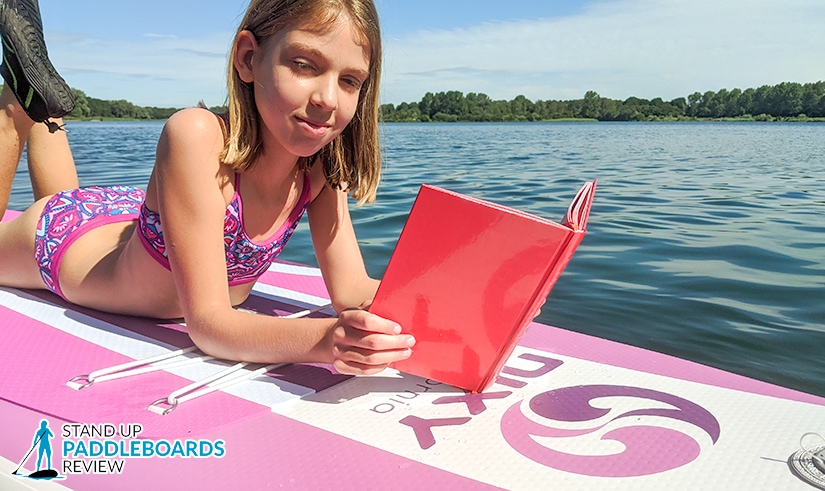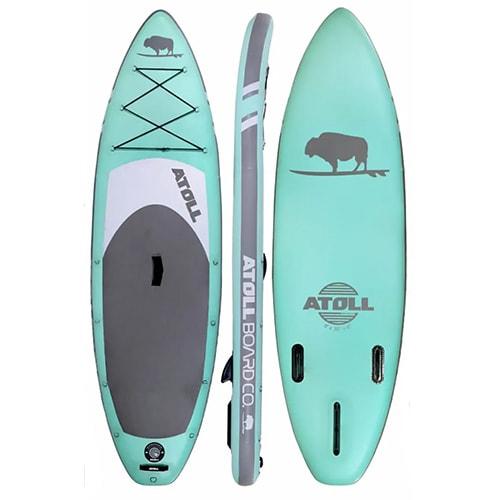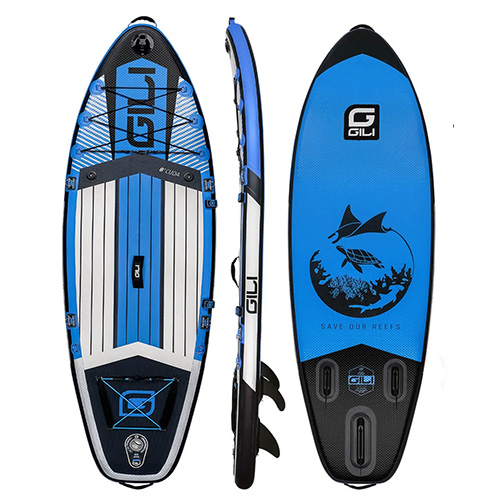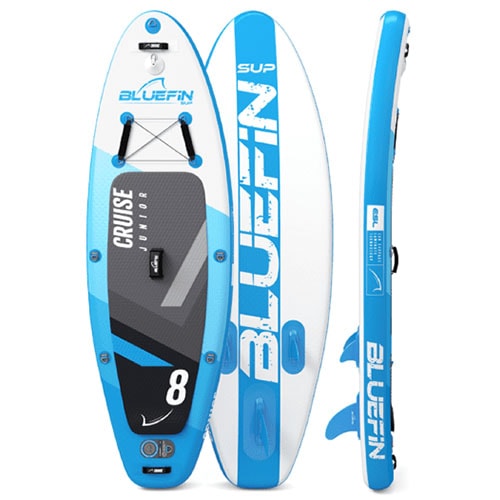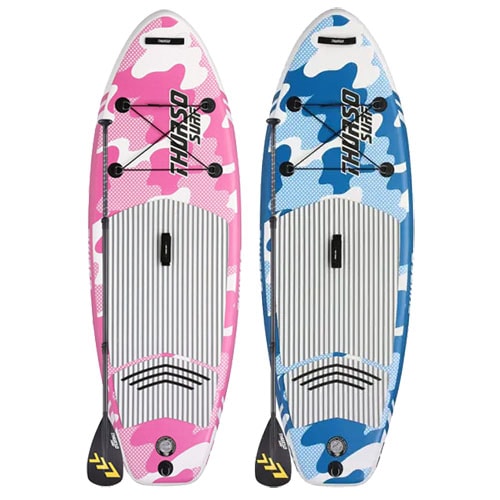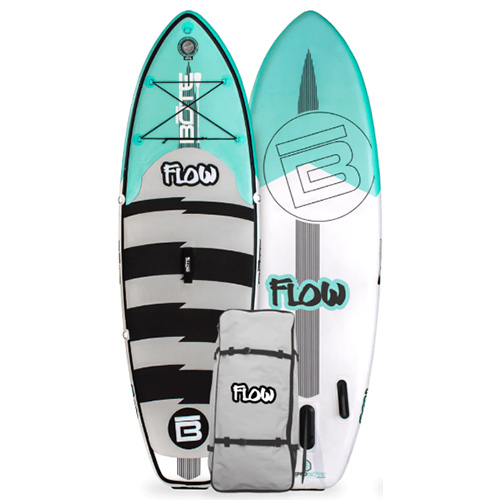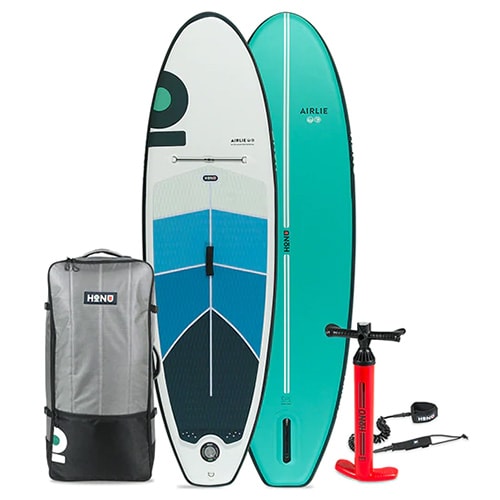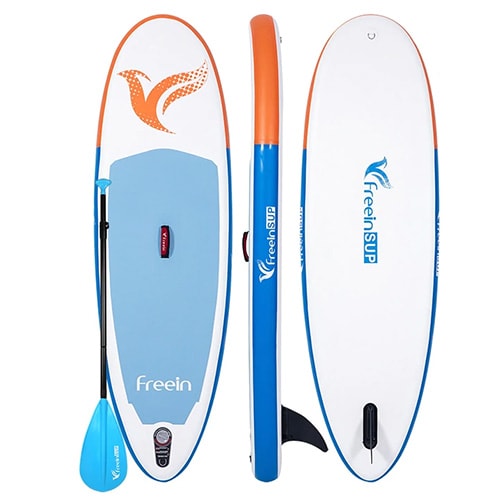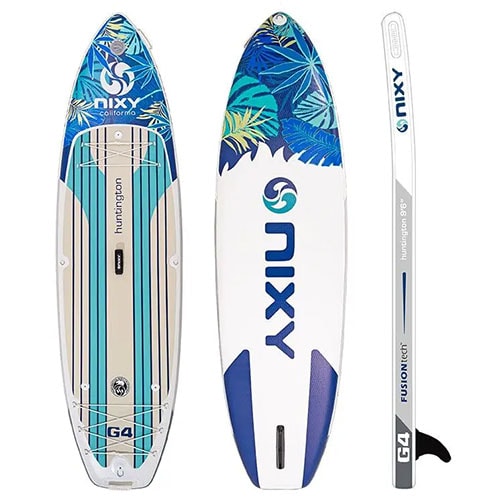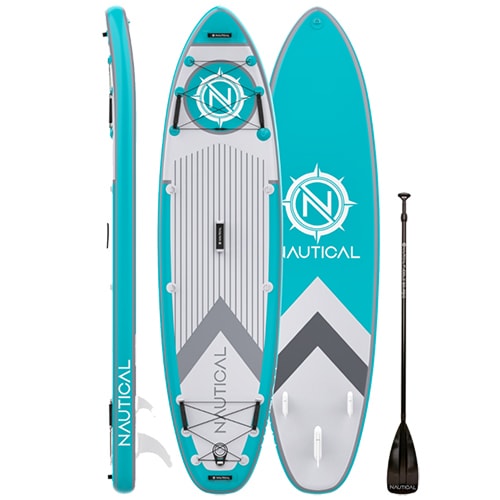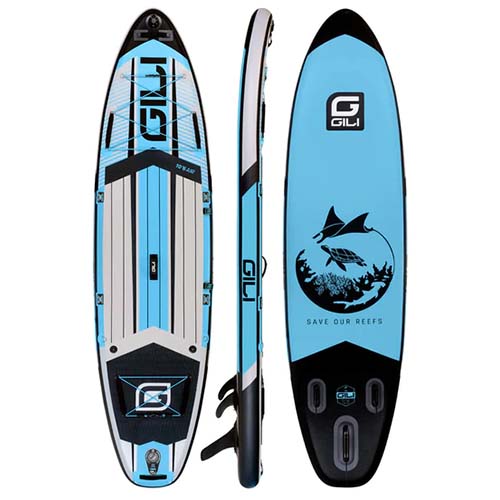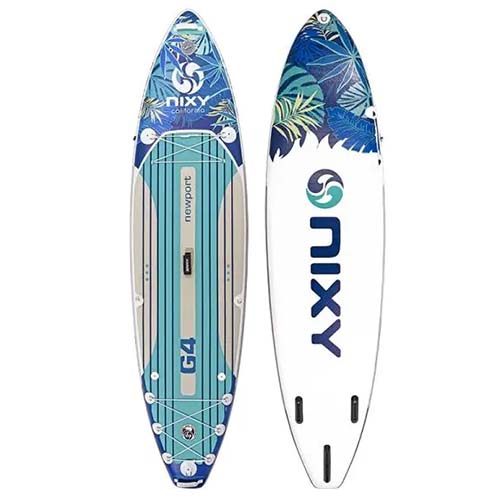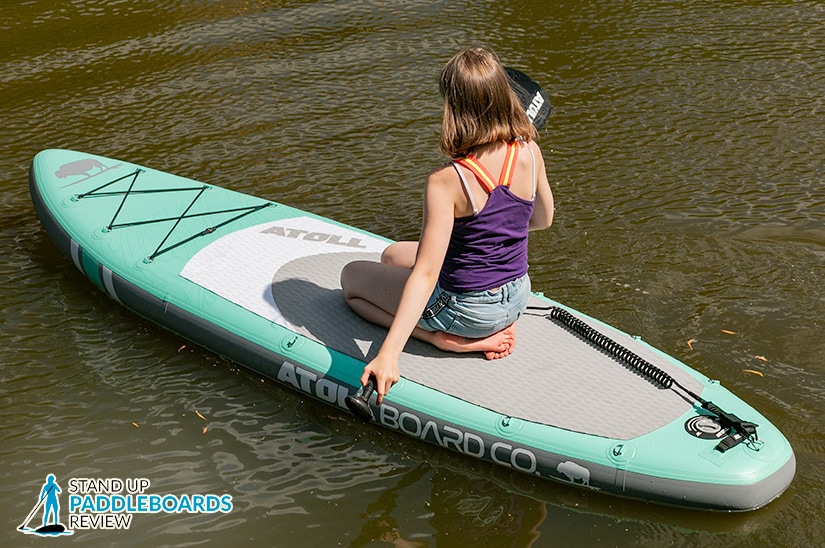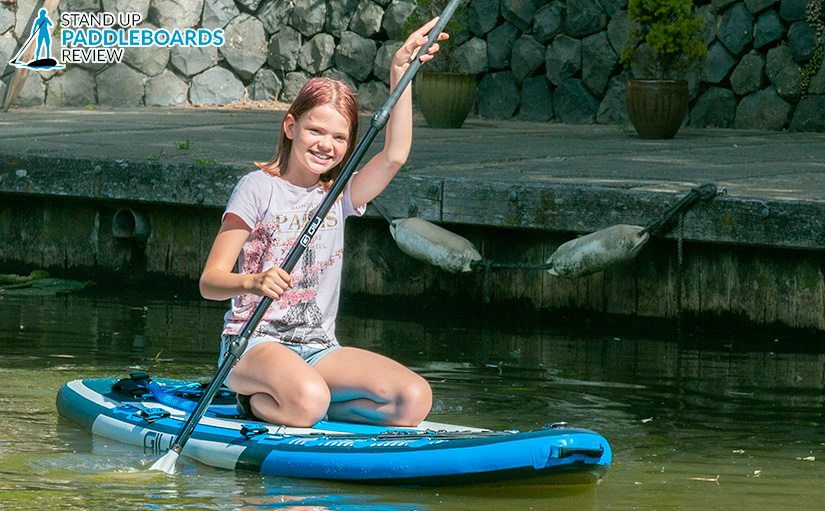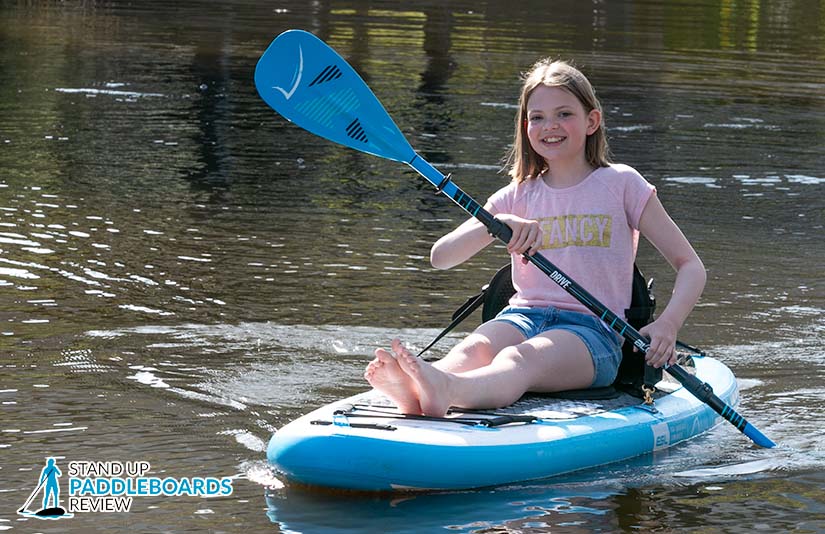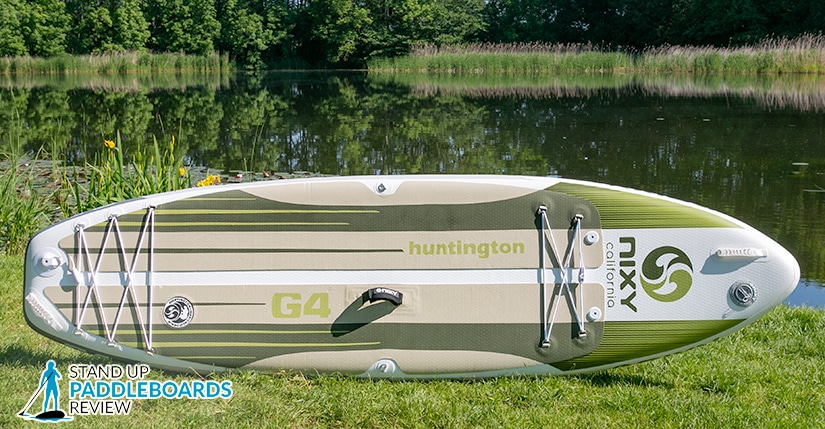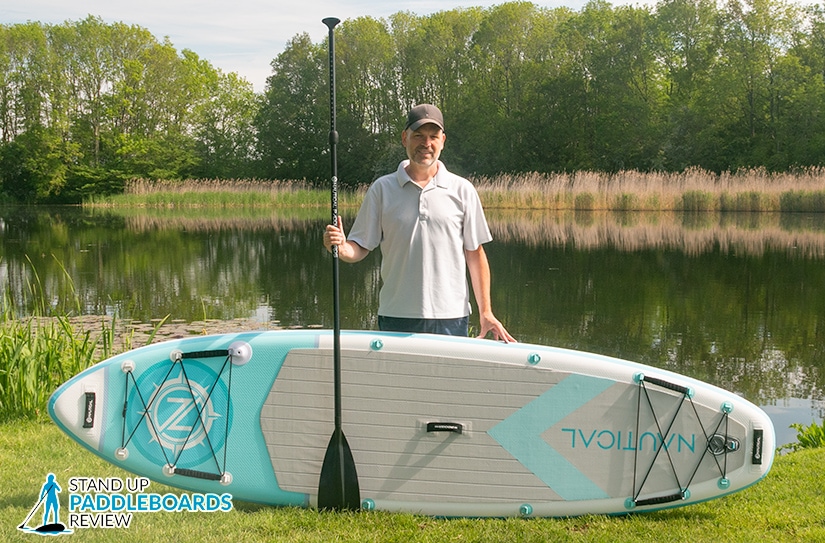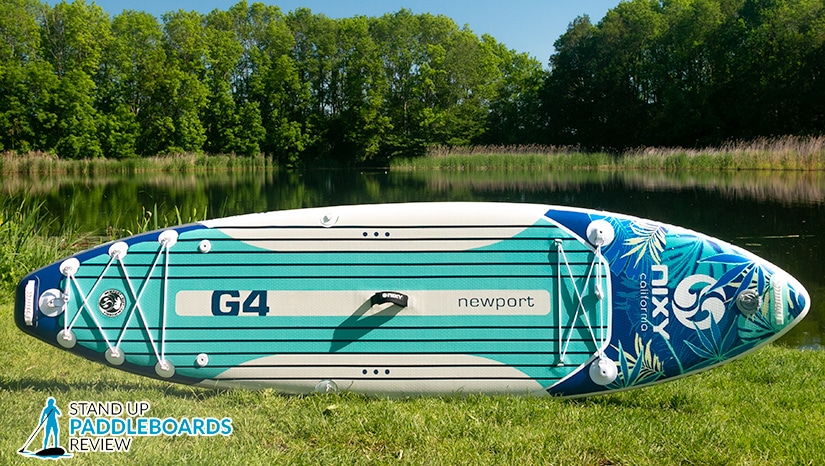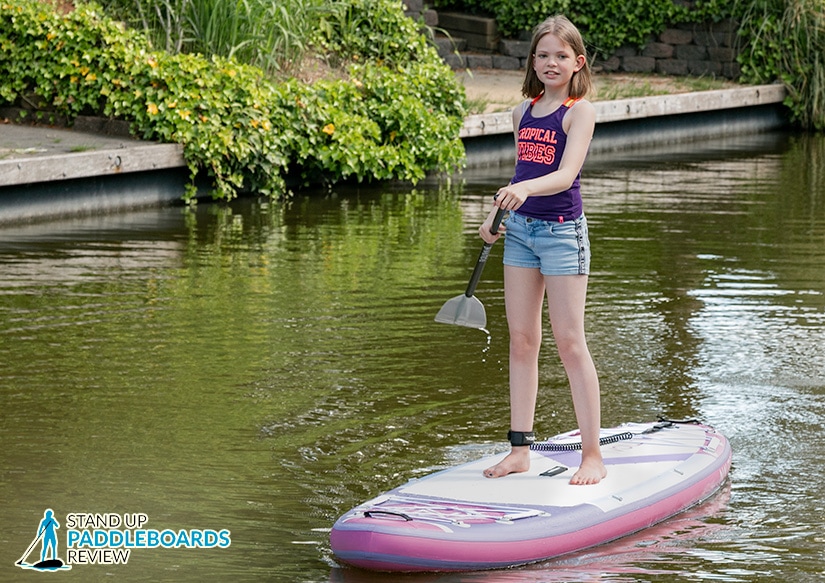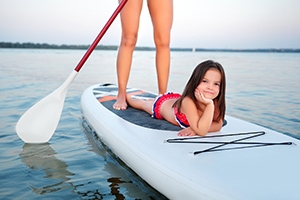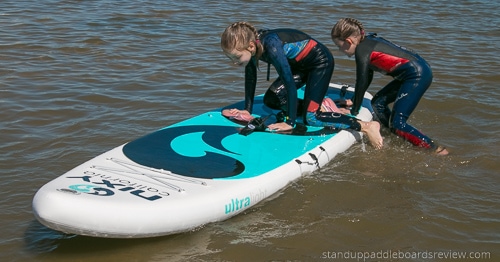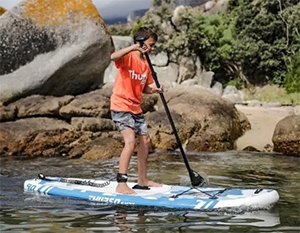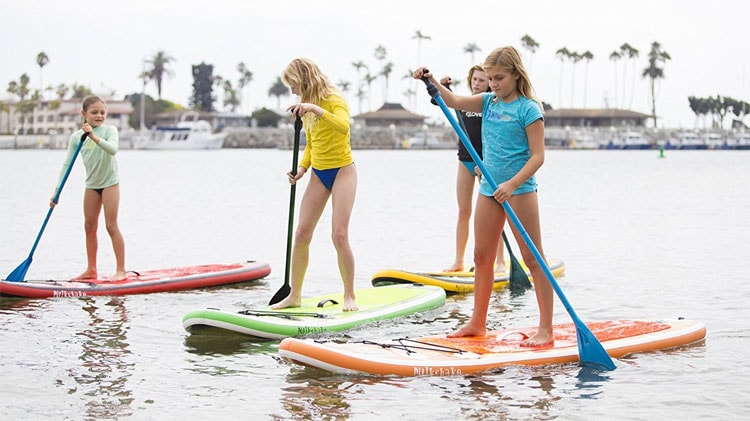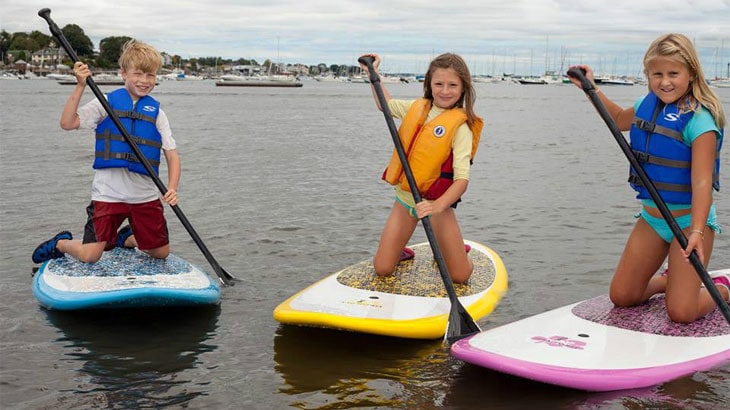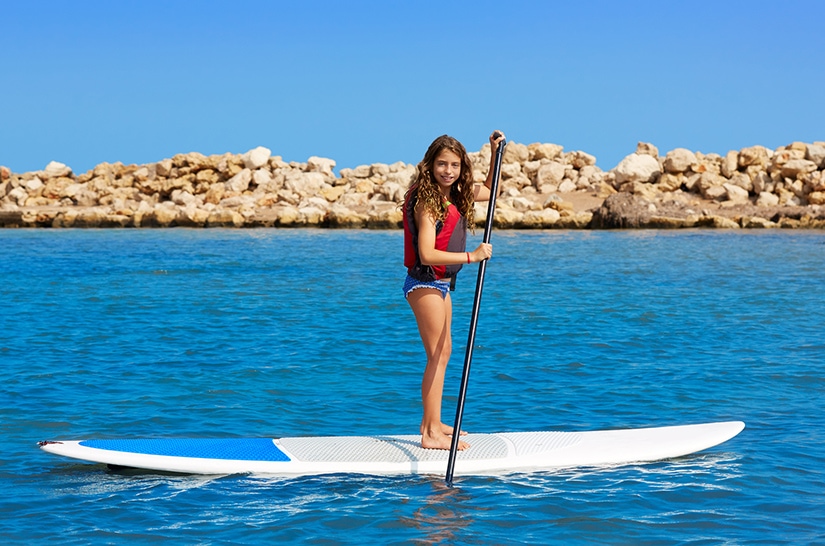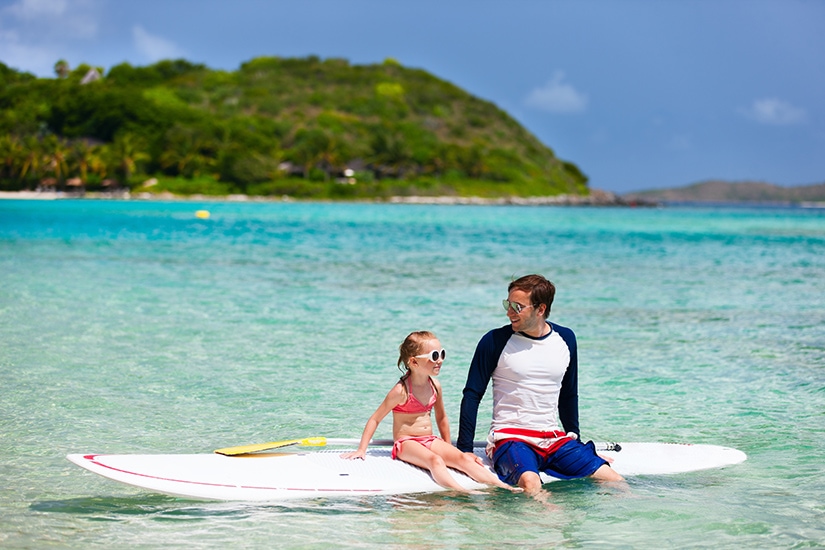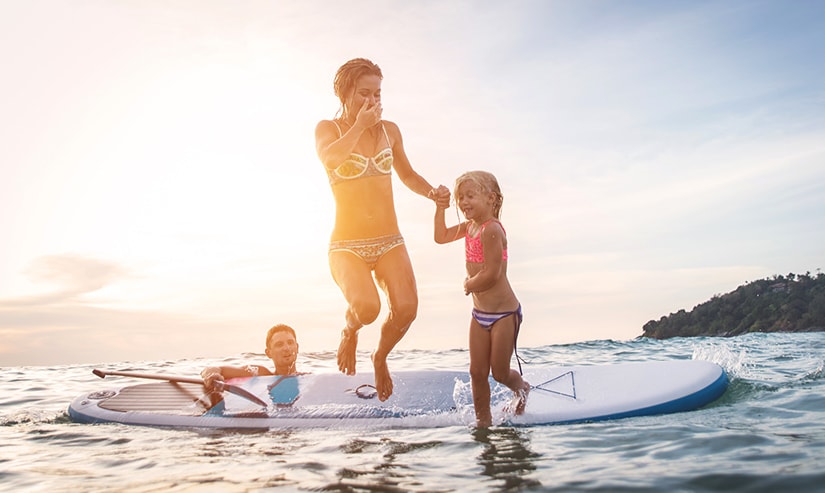If you’ve been taking your kids paddle boarding with you, at some point they may want to start paddling on their own. It’s heartwarming to see your children interested in an activity you love.
Few things are better than paddling alongside your little ones–having fun, exercising, and making beautiful memories with them. Getting them their own paddle board is a nice way to encourage this interest.
Even though you are buying a kids paddle board, it is still important that you get it right. You want your children to be comfortable and have fun in the water.
I really enjoy the time I spend paddling with my kids and I like to help other families get out there and enjoy all that SUP has to offer too. So here, I recommend my 12 best stand up paddle boards for kids. Just as important, I include a guide to help you choose a SUP that perfectly suits your child’s needs.
We tested a number of children’s boards and we settled on the Atoll as the best kids paddle board. My kids loved it and I’ll explain why below. So keep reading.
Kids Paddle Board Comparison Table
Best Kids SUP
Well-Made Kids’ SUP with Great Speed
| Sizes | 9′ x 30″ x 6″ |
| Weight | 21 lbs |
| Capacity | n/a |
Best Features
A Feature-Packed SUP, Available in Two Sizes
| Sizes | 8′ /9′ x 30″ x 4″ |
| Weight | 17.5 /18 lbs |
| Capacity | 95 /130 lbs |
Best Package
Durable Kids’ SUP for Younger Kids with Kayak Conversion Kit
| Sizes | 8′ x 29″ x 5″ |
| Weight | 17 lbs |
| Capacity | 264 lbs |
High-Quality Yet Affordable, With a Two-Year Warranty
| Sizes | 7’6 x 30″ x 4″ |
| Weight | 19 lbs |
| Capacity | 165 lbs |
Rugged Construction But Super Lightweight
| Sizes | 8’6 x 27″ x 4.7″ |
| Weight | 11.9 lbs |
| Capacity | 135 lbs |
Fun to Use and with an All-inclusive Package
| Sizes | 7’8 x 28″ x 6″ |
| Weight | 21 lbs |
| Capacity | 176 lbs |
Best 4 Older Kids
Wide, Stable, and Versatile Board
| Sizes | 9’6 x 32″ x 6″ |
| Weight | 17 lbs |
| Capacity | 250 lbs |
Great Affordable Paddle Board for Teens
| Sizes | 10’6 x 32″ x 6″ |
| Weight | 20 lbs |
| Capacity | 240 lbs |
Gili Air 10’6’’ Inflatable SUP
Versatile Paddle Board, Ideal for Experienced Teens
| Sizes | 10’6 x 32″ x 6″ |
| Weight | 19 lbs |
| Capacity | 280 lbs |
Large Stable SUP with Premium Accessories
| Sizes | 10’6 x 33″ x 6″ |
| Weight | 21 lbs |
| Capacity | 300 lbs |
12 Best Stand Up Paddle Boards for Kids and Teenagers
1. Atoll 9’ Kids Paddle Board – Best Performance
Atoll is another reputable iSUP company that has recently added a kids board to their lineup.
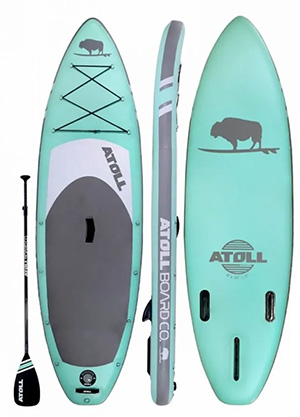
The Atoll 9’ is 30 inches wide, two inches narrower than the iRocker Nautical Kids SUP. It’s stable enough for my daughter to paddle without any issues, but not as stable as the Nautical, and not as easy to turn.
However, she found it faster than the Nautical, and it glides with great speed. If you have an adventurous young paddler they’ll love how quick this board is.
The Atoll comes with a nice backpack, coil leash, high-pressure pump, and a fiberglass paddle. The paddle is adult-sized and my five-foot daughter uses it when it’s adjusted to the shortest length. I imagine it would be too long for a shorter kid, but it’s perfect for tall kids. It also feels a little heavier compared to the Nautical paddle.
Like the adult Atoll board, this youth paddle board has a three-fin system. The side fins are fixed but the center fin is removable and has a U.S fin box. This universal fin box means that you won’t struggle to find a replacement if it accidentally gets damaged or lost. But it can be harder to use than the snap-in fin boxes of the Cruise Jr and the Nautical Kids.
The Atoll paddle board for youth is available in two colors: army green and aquamarine. They look great and are suitable for paddlers who don’t like boards that are too bright. I love that the paddle and backpack are color-matched to the board–they look pretty cool.
Like the adult Atoll SUPs, the kids paddle board has a minimalist design. There is a six-point bungee storage area at the front and extra D-rings for attaching accessories like a kayak seat.
If you want a narrower and faster but stable paddle board for your child, the Atoll 9’ is a fantastic option.
- Good speed: The Atoll 9 glides smoothly and offers a fun ride for kids. It glides well, so kids can paddle longer distances with less effort.
- All-inclusive package: Everything that your young paddler will need to hit the water right away is included in the package – which I love! The accessories are high-quality too.
- Quality construction: Like the adult Atoll paddle boards, the Atoll 9 is built using machine-laminated dual-layer PVC. It can take a lot of use and abuse without coming apart.
- Universal fin-box: If your child accidentally damages the fin, you can easily find a replacement. Most aftermarket fins will fit.
- Size of the paddle: I wish the paddle had a shorter adjustment setting to accommodate kids of all heights. But if your child is taller they won’t have an issue.
- Few color options: The Atoll 9 only comes in two colors. If your child wants a vibrant SUP this may not suit them.
Check Price of the Atoll 9′ Kids
2. Gili Cuda
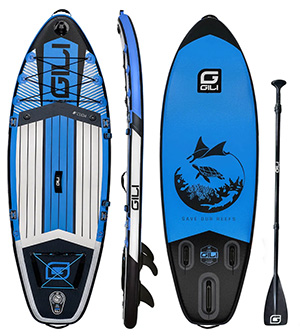
The Gili Cuda comes in 8-foot or 9-foot versions. Both are 30 inches wide and are similar in weight. I’d recommend the 8-foot model for lighter kids under 5 feet tall. The 9-foot model is better for taller, heavier kids and more experienced paddlers, as the length/width ratio makes it a bit less stable – but faster in the water.
The Cuda feels more stable than the Bluefin Cruise. It’s narrower than the Nautical, but the shape makes it a little easier to paddle. Overall, I think this board offers a great balance of stability and performance.
The best thing about the Gili Cuda is its features. It’s the perfect board for kids who want to go on longer paddling expeditions or customize their setup with accessories.
You get a huge bungee storage area at the front of the board and a smaller (removable) one at the rear. Three action mounts let you attach a GoPro, phone, waterproof speaker, or a fishing rod to the board, and there are extra D rings to fit a kayak seat. This is the only board to come with straps to attach your paddle – a feature you’ll appreciate after your child drops their paddle in the water for the tenth time…
I have to say, I’m not a huge fan of the Cuda’s duffel storage bag. I would have preferred a backpack that’s easier for kids to carry. That said, if you can park near your launch site and don’t have to carry your SUP far, then this may not be an issue for you.
Gili also doesn’t provide a pump for this SUP (though you can add a manual or electric pump as an optional extra). This isn’t a deal-breaker for me, as my kids paddle with us and we always bring an electric pump to save our arms! The paddle, leash, and snap-in fins are all good quality, and the fins are super easy to install.
Gili donates a portion of profits to ocean, reef, and turtle charities. This and the cute turtle logo on the underside make the Cuda a great choice for an animal-loving environmentalist!
- Three action mounts: Whether they want to record their paddle boarding antics on a GoPro to show their friends, attach a cup holder, or try a bit of fishing, there’s the option to attach multiple accessories.
- Integrated paddle holder: I love this simple but incredibly useful feature. It’s great for making sure your kids don’t lose their paddle or drop it overboard. I wish more SUPs had this feature!
- Good balance of stability and performance: The Gili Cuda isn’t quite as stable as my top pick (the Nautical), but it’s a great option for confident youngsters.
- Supports marine conservation: I love that Gili supports charities that help protect our oceans – I mention this often, but it is truly worth remarking upon. Gili donates a portion of every purchase to one of many marine life charities.
- No backpack: The Cuda’s over-the-shoulder carry bag is large enough for your board and accessories, but the design isn’t easy for young kids to carry. If you can park up close to the water, this may not be an issue.
- Only one design: Gili has a great range of colors for their adult boards, so I was disappointed to see the Cuda only comes in blue. It does have a cute turtle design though!
3. Bluefin Cruise Jr. 8’ – Kids Paddle Board with Kayak Kit
Bluefin paddle boards are some of the most rigid inflatables you can find. I find it impressive that the company put that same effort into making this kids paddle board.
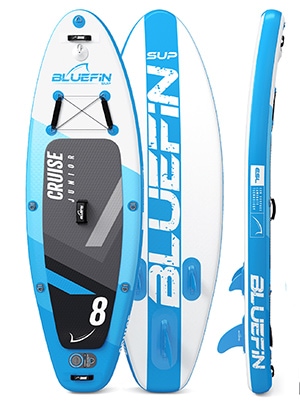
The Cruise Jr is made using 1000D exo surface laminate PVC and pro-weave dropstitch. On top of that, it has heat-welded double-side rails.
You know kids can be adventurous and a little rough sometimes. With the Cruise Jr, you don’t have to worry about dents if they drop the SUP or bump into anything. Like every other Bluefin board, it is solid and comes with a five-year warranty.
It’s amazing that the manufacturer included a kick pad feature. It allows a paddler to make quick sharp turns. My daughter had no problem maneuvering it and she found it fast too.
The paddle board also comes with a diamond-croco deck pad, a fixed GoPro mount, bungee storage, and D-rings. Your child can carry their own accessories and even attach an action camera. I love that it has five grab handles so the kids can pull it into and out of the water on their own without a problem.
Another reason why I think you should consider this paddleboard for your child is the iSUP package. It includes a manual pump, backpack, ankle leash, paddle, and a kayak conversion kit.
The adjustable paddle is made of fiberglass. It is lighter than aluminum and perfect for young paddlers.
The kayak conversion kit includes a kayak seat and kayak paddle blade. Sometimes the wind gets too strong for my kids to paddle. But with the conversion kit, they can sit and paddle without a problem. So we don’t have to finish our SUP sessions when they haven’t had enough. They love it!
In terms of performance, the Cruise is stable and maneuverable. You can be sure that your kid won’t be struggling to control it when paddleboarding. It is only 8 feet long and 29 inches wide.
However, I’d recommend it for shorter and lighter kids. My 11-year-old daughter is five feet tall and about 86 pounds and the Cruise Jr is a little unstable for her. It would be better for kids who are 4’9 and about 75 pounds and below. If they’re taller and heavier than that a longer board like the Nautical would be more suited.
- Quality construction: The Bluefin Cruise Jr is built using 1000D laminate PVC and pro-weave drop stitch, making it extremely durable and rigid when inflated. It even comes with a five-year warranty period–the best warranty period in the industry.
- Inflatable paddle board package: On top of a fiberglass paddle, pump, backpack, and leash, the Cruise Jr also comes with a kayak conversion kit. Your little paddler can alternate between sitting and standing (great if they’re not super experienced paddler yet)
- Maneuverable: This kids’ paddle board is responsive and easy for kids to handle while in the water. The kick pad feature at the tail allows them to easily learn turning techniques such as the step-back-turn.
- Nice deck pad: The diamond deck pad is comfortable enough for small feet to stand on for hours. It will also prevent them from slipping when the board is wet.
- Side fins are not removable: You can’t switch to different setups (but at least the fins can’t get lost).
Check Price of the Bluefin Cruise Jr
4. Thurso Prodigy 7’6
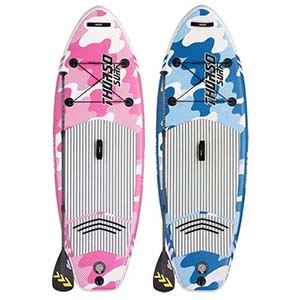
A great kids SUP doesn’t have to be expensive. The Thurso Surf Prodigy is affordable but very well made.
The manufacturer applied the standards they use for their regular paddle boards, and they offer a two-year warranty.
You can get the Prodigy in two colors–magenta and azure–and they are both gorgeous. Other than the appearance, I think kids will love having a bungee cord attached to D-rings at the front. They can bring their own dry bag/deck bag on family SUP trips.
The inflatable stand up paddle board also features a three-fin system, all removable, and two grab handles. The fins are super easy to set up, a child can do it.
The iSUP package includes a carbon shaft paddle, backpack, and leash. Thurso Surf didn’t include a hand pump because they figured parents already own one for their adult boards.
I must say the paddle is really nice. Carbon is the lightest and most efficient material for making SUP paddles. It is also the most expensive so you’re getting a good deal.
The paddle board only weighs 19 pounds and can support up to 165 pounds. It is recommended for children aged five and up.
If you are looking for an affordable but high-quality children’s paddle board, you should check the Prodigy out.
- Premium accessories: The Prodigy junior paddle board comes with a comfortable leash, easy-to-carry bag, and a carbon hybrid paddle. I love the paddle because it’s high-quality and lightweight–perfect for kids.
- Wide and stable: This inflatable board is 30 inches wide and stable enough for kids to learn on. It has a wide nose and they can have fun without fear of falling off every time they try standing.
- Well-made: It’s a kids SUP but Thurso still uses dual-layer construction to make sure it’s tough and long-lasting. Young paddlers can be free to explore without worrying about dents (plus it comes with a two-year warranty).
- Short and maneuverable: It’s such a great choice for younger kids because they’ll find it easy to handle.
- No pump in the package: It would be nice if it came with a pump but you can still use the parent’s or family’s pump.
Check Price of the Thurso Surf Prodigy
5. BOTE Flow Aero
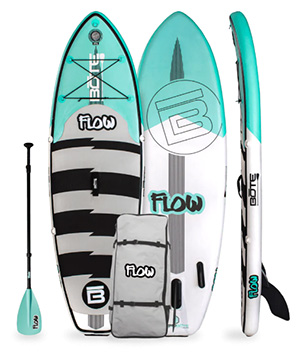
The BOTE Flow Aero is a great paddle board for kids of all ages. It’s 8 feet long and 30 inches wide, making it stable and easy to maneuver. Children as young as four can handle this board solo – so it’s a great option if you want to start them paddling young!
BOTE boards are renowned for their quality and the Flow is made from the same military-grade PVC as the larger boards. It’s built to last, so you don’t need to worry if your kids are less than gentle with it.
The Flow Aero has a large center fin and two side fins. The side fins aren’t removable, so you’ll need to take care not to damage them when rolling up your board. On the plus side, this means they can’t get lost!
The 100-pound capacity is lower than other boards, but knowing BOTE’s quality construction, I suspect you could push this without it affecting the performance of the board too much.
There’s a D ring at the front of the SUP, which you can use to anchor or tow the board if your little one is getting tired. The bungee storage area is large enough for a small dry bag and there’s a set of D rings that you can use to attach a kayak seat or BOTE’s inflatable seat. An extra grab handle at the nose would have been nice, but it’s not a deal-breaker as the board is pretty light to carry.
The Flow Aero comes with a 3-piece fiberglass paddle, hand pump, repair kit, and a travel bag. One thing to be aware of is that the paddle doesn’t float – if you drop it in the water, you’ll need to make a quick grab for it! I found it a little odd that the package doesn’t come with a leash, but these aren’t expensive to buy separately.
- High-quality construction: I love BOTE’s premium construction, and this kid’s paddle board is just as well made as their adult boards. So if you’re concerned that the kids model is a watered down version of BOTE’s adult boards, don’t be.
- Very stable: The Flow Aero is a perfect SUP for kids to learn on as it’s so stable. The pointed nose and long center fin mean it tracks well and is smooth to paddle.
- Large deck area: The lack of bungee cord or other obstructions at the rear of the board makes it easy for kids to practice step-back turns and other maneuvers.
- Low weight capacity: Heavier teens may find that their weight affects the performance of the board, but this won’t be an issue for most kids.
- No leash: You don’t get a leash with the board, but these aren’t too expensive to buy.
Check Price of the Bote Flow Aero
6. Honu Airlie 8’6 Kids All-rounder
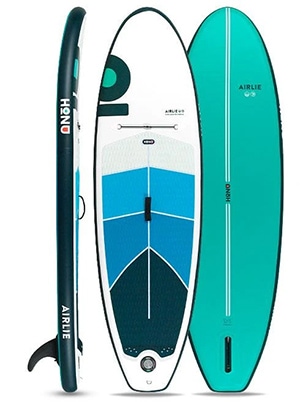
The Honu Airlie is extremely lightweight, weighing only 11.9 pounds. It is the lightest model here and it is perfect for really young paddlers.
But don’t let that fool you.
Despite being so light, the Airlie is built using X-Woven and fused dropstitch material. Believe me when I tell you that it can take a beating. It comes with a two-year manufacturer’s warranty and an extra two years of free repairs.
The 8’6 length and large center fin offer great tracking in the water. It also helps that the stand up paddleboard is not too wide so it’s not sluggish. Kids will find it easy to control too.
The Honu Airlie comes with a travel backpack, manual pump, ankle leash, and a repair kit. Unfortunately, the SUP package doesn’t include a paddle. They, however, give you a 20% discount when you buy it with the SUP board.
The paddle board features a single-fin system.
Small children will appreciate the Airlie because it is light and easy to carry. It also performs well in most conditions and offers an amazing experience.
- Lightweight: This is the lightest kids paddle board here. At just 11.9 lbs little paddlers won’t have a problem carrying it by themselves..
- A very tough SUP: It may be lightweight but the Honu Airlie is still super tough and can handle all the rough situations your young paddler puts it in. It comes with a four-year warranty too.
- Stable and maneuverable: The Airlie is neither too long nor too wide and kids can easily control it and have fun.
- No paddle in the package: You’ll have to buy a paddle separately – but Honu gives you a discount if you buy it with the SUP.
Check Price of the Honu Airlie
7. Freein Youth SUP
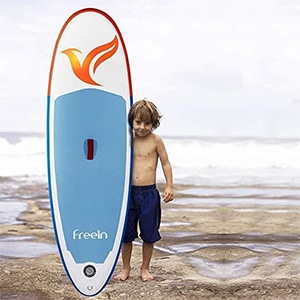
Freein SUP are known for offering affordable inflatable SUP packages. Although their boards are cheap, they are built to last.
The Freein Youth kids paddle board is built using dual-layer construction and additional coatings on the side and deck. This impressive PVC construction makes it durable but still lightweight. It weighs 20.9 pounds and has a maximum weight capacity of 176 pounds.
We love that this paddleboard comes with a two-year warranty. This is not common with cheap paddleboards; so you know it is a quality SUP.
The Freein Youth board is 7’8 long, 6” thick, and 28” wide with a rounded nose. It is super stable. It would be great for building a young paddler’s confidence in the water. It comes with one removable center fin to help with performance.
In addition to the inflatable SUP, you will get a paddle, travel backpack, repair kit, hand pump, and an electric pump adapter. The aluminum paddle is expected because it is a cheap package. A leash is not included.
If your budget is really tight but you still want a stable and well-made SUP for your child, you should consider the Freein.
- Cheap: I love Freein paddle boards because they’re cheap but still great. The Freein youth SUP is ideal if you want a good board (or two) without breaking the bank.
- Clear platform: This kids SUP board doesn’t come with extra D-rings, bungees, or gear mounts and your child will have a clean surface to have fun and maybe even try a few yoga poses.
- All-inclusive package: It’s a cheap inflatable stand up paddle board but it comes with everything your little paddler needs to hit the water.
- It’s a little heavy: The Freein inflatable SUP is on the much smaller side but it’s one of the heaviest here.
- Aluminum paddle: It can be a little heavy for kids too but it’s to be expected for the price.
Check Price of the Freein kids
8. Nixy Huntington Compact – Best For Older Kids
The Nixy Huntington is designed for adults who like to travel with their SUPs but it makes a fantastic kid SUP board.
Older children will love having this inflatable SUP, especially given the features it offers. It comes with two bungee storage areas, at the front and back. The board also has action mounts and additional D-rings.

They can bring their own gear and accessories, including fishing rod holders. There won’t be a reason to leave them behind when you go SUP fishing or camping.
The Huntington Compact has a large non-slip deck pad. It keeps the paddler comfortable and prevents them from slipping and losing balance. Wet paddle boards can be slippery.
It also comes with two removable fins.
We think the iSUP package is nice. It includes a paddle, backpack, repair kit, hand pump, and leash. The carbon hybrid paddle is lighter than aluminum and fiberglass paddles. It is also adjustable from 70” to 86”. The backpack has wheels–great for traveling.
The Huntington Compact is lighter than most paddle boards of the same size, weighing only 18.75 pounds. This is one of the reasons why it is such a good kids board. Youth paddlers won’t have a problem carrying it on their own, even when it is fully inflated.
While it may be lightweight, the Huntington is definitely not a cheaply made SUP board. It is built using dual-layer PVC material and it has reinforced rails. The rigidity is unmatched and it feels like a solid paddle board.
We recommend the Huntington Compact for older kids because they can continue to use it even when they’re adults.
- Premium iSUP package: The Huntington Compact SUP package includes some of the best accessories I’ve seen with comparable paddle boards – the adjustable carbon hybrid paddle alone is a fantastic addition!
- Stable and easy to control: This paddle board is moderately wide and not too long. Older kids can play around and try paddling in different conditions.
- Remarkable construction: The Huntington is built using dual-layer PVC. It feels solid and durable, so you won’t have to worry every time your child drops the SUP or bumps it against something.
- Gear mounts: If the teen paddlers want to add accessories such as an action camera they can do so easily because the SUP comes with gear mounts.
- Not cheap: For a children’s paddle board, the Huntington is not cheap but it’s worth it.
Check Price of the Nixy Huntington Compact
9. iRocker Nautical 10’6’’ – Best For Teens
This is one of the best budget inflatable paddle boards for kids and adults alike.
The iRocker Nautical is a performance kids board. It tracks well and is fast. Older kids can use this SUP to paddle flatwater and slow-moving rivers as well as ocean paddling.
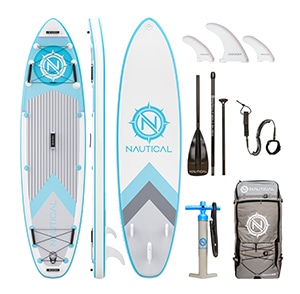
If you have a teen who is passionate about paddleboarding, this would be great for them.
iRocker is a well-known brand and their paddleboards are made to last. So it’s no surprise that the Nautical is built using dual-layer military-grade PVC. It is sturdy and has a weight limit of 240 pounds, making it a good option for heavier kids.
This is a paddle board that your child can still use even as an adult. It comes with bungee storage at the front and back, D-rings, and an action mount. I also love that the SUP board has safety handles.
The Nautical features a three-fin system and all fins are removable. While removable fins can easily get lost, the SUP folds compact without them and this makes transport and storage easier.
You’ll be happy to know that the iRocker Nautical comes with everything your kid needs to start paddling. You only have to buy a PFD. The package includes a fiberglass paddle, backpack, leash, repair kit, and dual-action hand pump.
If your young paddler likes to travel with their SUP, the backpack has a wheel option. You can buy the Nautical wheels from iRocker.
- Great performance: I love that the iRocker Nautical is stable, maneuverable, but still fast enough for a fun ride.
- All-inclusive, affordable package: iRocker makes amazing accessories so it’s a great deal for the price – the included accessories are all high quality.
- Attachment points: The Nautical comes with two bungee storage areas, D-rings, and an action mount so the young paddler can carry their own gear.
- Cool design and colors: I like the colors of the Nautical and the overall design. It would appeal to the older kids.
- No U.S fin box: iRocker boards don’t have a universal fin box so you can’t just use any aftermarket fins. But if your kid loses a fin you can easily get a replacement from iRocker.
Check Price of the iRocker Nautical
10. Gili Air 10’6’’ Inflatable SUP
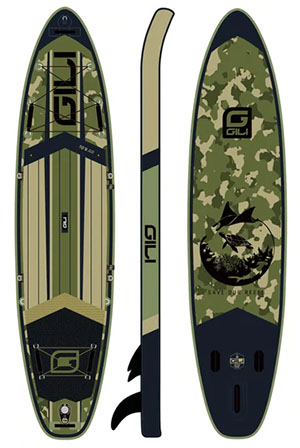
The Gili Air is not exactly a kids stand up paddle board. Like the Nautical, it is an adult paddle board that would be perfect for older children as well.
This inflatable stand up paddle board is only 10’6 long and 32 inches wide. The size makes it stable, fast, and easy to maneuver for kids. It has a weight capacity of 280 pounds and can hold a heavy kid or a child and a smaller adult.
The Air comes in beautiful colors that your child might like: blue, green, coral, teal, orange, and camo.
Gili Sports is yet another company known for making quality SUPs. This one is built, using military-grade PVC and comes with a two-year warranty. It is a really tough paddle board that doesn’t get easily dented.
Your junior paddler can continue using the Gili Air even as they get older. It has features that will allow them to participate in some more advanced SUP activities. It comes with three action mounts, bungee storage, and D-rings for attaching gear and accessories.
They can bring fishing rod holders, an action camera, enough gear for short touring trips, and much more.
The SUP package includes an aluminum paddle, backpack, leash, and a dual-stage manual pump. The aluminum paddle is not that heavy–it even floats.
One awesome thing about buying a Gili paddleboard is that a percentage of each sale goes to ocean charities. So your kid gets a good SUP board and you help save the world’s oceans!
- Fun and responsive: The Gili Air is such a playful board, even in mildly rough conditions. Young adventurous paddlers can have so much fun with it.
- Six beautiful colors: I love the wide range of color options and kids can pick whatever they like (there’s something for everyone!)
- Save the oceans: Every time you buy a Gili paddle board, a portion of the sale goes to saving the world’s oceans.
- Well-made: The Gili Air is built using military-grade PVC and comes with a two-year warranty. It will last a long time and they can grow with it.
- Can be unstable for some paddlers: Much older kids may have trouble with balance, especially if they are taller and new to SUP.
- Aluminum paddle: For the price, you’d expect a fiberglass paddle. But for a slightly higher amount you can have a fiberglass paddle in the package.
11. Nixy Newport 10’6
Lastly, I have the Nixy Newport youth paddle board. It is another adult-sized SUP that would be great for older or heavier kids.
The Newport is long and wide at 33 inches. It is exceptionally stable and your kid won’t find it wobbly or tippy regardless of their size. This paddleboard will give them the confidence they need to pursue their interest in paddle boarding.
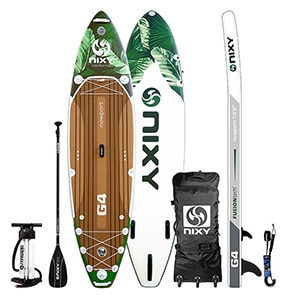
Remember: anyone can paddleboard, regardless of their skill level and body size. They just need the right board.
The Newport is made using dual-layer PVC material and has reinforced carbon rails. It is very rigid and won’t sag at all. It has a weight limit of 300 pounds.
This would also be a nice board for adventurous kids with advanced SUP skills. It comes with five action mounts, bungee storage, and extra D-rings. These features, plus the high weight capacity, make the Newport ideal for almost any SUP activity.
It can be a SUP for camping, fishing, yoga, and relaxed cruising. The paddle board can even hold multiple kids–the more the merrier, right?
The Newport package includes a carbon hybrid paddle, wheeled backpack, triple-action hand pump, and an ankle leash. I love the premium quality accessories because you won’t have to upgrade them.
- Perfect for older and bigger kids: The Newport is wider with a higher weight capacity than similar SUPS – so it can hold bigger kids, and teens (great for older kids who are growing – as they won’t outgrow it right away)
- Premium iSUP package: I love all the accessories and you won’t need to upgrade them. The kid can continue using the paddle even when they start getting more serious with SUP.
- Built for adventurous kids and teens: The SUP has multiple D-rings and gear mounts, so your our teen paddler can attach all kinds of accessories for SUP adventures (like fishing or SUP camping)
- Quality construction: Nixy boards are built to last and the Newport is no different. The dual-layer PVC construction makes it virtually indestructible and it has a two-year warranty.
- It’s not cheap: It’s on the more expensive side for a child’s board but it’s quality and they can use it even as adults.
Check Price of the Nixy Newport
12. Nautical Kids’ Paddle Board – Best Kids SUP
The Nautical paddle board for children is the newest addition to iRocker’s SUP collection. I’ve used several of their adult boards and I loved them so I was curious to see what the Nautical kids SUP is like.
It definitely didn’t disappoint!
As far as paddling goes, my daughter, who is 11 years old, found the board to be really nice to paddle, with not too much force required. It’s easy to turn and it glides well, and – like the parent-size Nauticals – feels to be of great quality.
The Nautical Kids SUP comes with a fiberglass paddle, leash, pump, and a SUP backpack. The paddle is kid’s size and it feels light and durable. However, it’s almost a little too short for my daughter (who is about five feet tall).
This Nautical paddle board for kids is available in four beautiful colors: teal, lime, yellow, and purple. My daughter loves the colors – and stated that she thinks it’s the best-looking kids board on our list.
I have to say that I agree with her!
I love that this children’s board has front and rear bungee storage areas, so your kid has enough gear storage options. There are four extra D-rings as well for attaching a kayak seat. The board also comes with seven grab handles. This, plus the fact that it only weighs 17 pounds, makes it easy for kids to handle.
The deck pad on the Nautical Kids board covers most of the deck, which means that your child will have a large comfortable surface. My daughters say it’s softer and more comfortable than the traction pads on the other kids paddle boards.
My kids enjoyed paddling the Nautical. It was really stable for them and not tippy at all. This allowed them to have so much fun without worrying about falling in the water too often. It also glides well and they had no problem maneuvering it.
I would easily recommend the Nautical Kids to any young paddler. The colors are pretty and appealing. Plus, it’s a durable board that comes with quality SUP accessories.
The SUP backpack is also pretty amazing–it’s the same premium quality that you get with the adult paddle boards.
- Great stability: I noticed how stable this kids board was when my daughters were paddling; it’s not wobbly and it will boost their confidence.
- High-quality accessories: I love that iRocker included the same quality accessories that come with their adult paddle boards. They’re durable, comfortable, and easy to use.
- Beautiful colors: The colors and patterns are stunning, most kids will love them. Besides, your child has four colors to choose from.
- Bungee storage and D-rings: When you tag your little one along on one of your longer trips they’ll have enough storage for their gear, which is awesome.
- Short paddle: The paddle is almost too short for my 11-year-old daughter. So while she can use the SUP even when she’s older, she’ll soon need a new paddle.
Buying Guide: How to Choose a Children’s SUP
You would think that buying a kids paddle board is an easy task. But it is not just any other cheap toy and safety in the water is important.
So here is all you need to know to make an informed decision.
What Is the Difference Between Kid and Adult Paddle Boards?
Kids boards and adult stand up paddle boards are similar in many ways.
The main difference is probably the size. Paddle boards designed for kids are smaller. A shorter and narrower SUP board is easier for a child to control.
Children’s boards are also thinner. You’ll notice that most adult boards, more so inflatables, are 6” thick. Kids boards, on the other hand, are about 4” to 5” thick.
You can also say that kids paddle boards are cheaper although this is not always the case.
Some boards made for kids can have bright colors and fun designs–especially those made for smaller children.
Lastly, kids SUP boards don’t have as many features as adult boards. A standard regular SUP will have D-rings, bungee storage, and at least one action mount.
Many children’s SUPs only have a D-ring or two for a leash and towing. But some, like the Thurso Prodigy, have one bungee cord storage area.
Inflatable Vs Hard Paddle Boards for Children
Should you buy an inflatable or hard paddle board for your kid?
I highly recommend inflatable paddle boards when it comes to kids.
You expect children to play around on their paddle board. They are also learning how to SUP. This means a lot of falling and, most likely, getting hit by the board. Blowup boards have a softer surface compared to a solid SUP. So the children won’t get hurt.
Kids can also be rough in how they handle a paddle board. Compared to hard SUPs, inflatables are much more durable. They bounce off obstacles instead of getting dented.
Another reason is that inflatable boards are generally cheaper than hard ones. You don’t want to spend a crazy amount on a board that your child will soon outgrow or dent.
A Dedicated Children’s SUP or an Adult SUP That Works for Kids?
Some of the kids paddle boards reviewed above are designed specifically for children. The rest are adult boards that work for kids. So which is the better option for your child?
For really young children and pre-teens, a dedicated kids paddle board makes more sense. They can easily carry it around and handle it on the water.
Older teens would be better off with adult boards that work for kids, especially if they are bigger and/or taller. These boards have a higher weight limit and they can continue to use them even as they grow into young adults.
If you’re still not sure, maybe the benefits of each SUP type will help you make up your mind.
Benefits of a Dedicated Children’s SUP
Kids paddleboards don’t have the many gear attachments–like bungee cords, accessory mounts–that you find on regular boards. Although this limits the amount of stuff they can bring, it also means that they won’t get their little feet caught up or trip on something.
Children’s boards can be cheaper. Many parents don’t see the point of buying an expensive SUP because the kid could outgrow it or even lose interest in paddleboarding.
Lastly, a kids board is smaller. Junior paddlers won’t have a problem carrying it, inflating, and controlling it in the water. It makes learning easier and more fun.
Benefits of an Adult SUP That Works for Kids
An adult board will typically have storage and attachment options. This allows the paddler to bring gear and accessories for different SUP activities.
Adult paddle boards perform better in almost any water condition.
Regular SUPs are bigger and have a higher weight capacity. Anyone in the family can use the board and some of them can hold multiple people. You can even have just one SUP for the whole family.
The biggest benefit is that kids will not outgrow an adult-sized paddle board. So although it costs more than a children’s SUP, you only have to buy it once.
What to Consider When Buying a Paddle Board for Kids
The next step is narrowing down your options to one perfect board. Here is what you should look at.
1. Affordability
Your budget will greatly influence your decision when buying a kids paddle board. Most of the boards reviewed here are affordable, but of good quality.
Buying an expensive SUP for a kid doesn’t make a lot of sense because they will outgrow it.
Even though you get them an adult-sized board, they may want to specialize once they become advanced paddlers. When that happens, they’ll need expensive performance boards.
2. Stability
Stability is a very important factor, especially when it comes to kids. A stable board makes them comfortable and boosts their confidence, making learning easier.
Wider boards are more stable. For younger kids, anything from 28 inches is ideal. If your child is older and/or on the bigger side, get a SUP that is at least 31 inches wide.
You should also check the deck pad. A grippy surface promotes balance by preventing the paddler from slipping.
3. Weight
A heavy paddle board will be hard for a child to carry around on their own. On the other hand, heavy boards don’t easily get tossed around in rough conditions.
But since it is unlikely that a child will be paddling in rough conditions, go for lighter boards.
4. Fin Setup
For a kids SUP board, the less complicated the setup, the better. You want permanently attached fins because they can’t get lost.
If they are removable fins, you should make sure they are snap-in fins that don’t need tools to attach or have small parts that could get lost.
5. Child’s Age
The age of your kid can help you determine what stand up paddleboard is right for them. That is, do they need a dedicated child’s board or an adult board they can use.
I’ve discussed this above. Dedicated kids boards are more suited for younger children. Older kids can use a smaller adult paddle board.
6. Durability
You can’t trust kids not to be rough when handling a paddleboard. They’re still learning and you can expect the board to get a beating. This is why I recommend inflatable paddleboards because they can take it.
But not all inflatable SUPs are made to last.
Make sure you get one that is built using multiple PVC layer construction. It is also advisable that you buy reputable brands and check the warranty terms.
Important Safety Tips for Youth Paddle Boarders
Safety first, always.
Teach the kids while they are still young and ensure they follow these safety precautions.
a. Always Wear a PFD
A PFD is designed to keep a swimmer afloat.
Buy an appropriate PFD for your child–not one meant for adults. Make sure they put it on properly when they go paddle boarding.
b. Wear a Leash
If they fall into the water, a leash will keep them attached to the paddle board. They won’t have a problem getting back on the SUP.
Make it a rule for everyone in the family to wear their leash before getting on the water.
c. Bring Enough Drinking Water and Snacks
It is impossible to have fun when you’re hungry and thirsty. Bring clean drinking water and snacks for your paddle boarding trip with kids.
Buy a SUP cooler to keep the refreshments cool.
d. Don’t Forget Your Sunscreen!
You should never forget sunscreen when paddleboarding with kids. Remember to keep reapplying whenever they jump in for a swim.
How to Paddle Board With Your Kids
How do you teach your kids to stand up paddle board? These ten principles will help you.
1. Manage Your Expectations: Children’s enthusiasm for paddle boarding might fluctuate. Focus on making the experience enjoyable without pressuring them immediately for prolonged interest or skill proficiency.
2. Swimming Skills: Ensure your child knows how to swim before they try paddle boarding, emphasizing safety and comfort in the water.
3. Right Gear: Equip your child with a suitable paddle board, paddle, leash, and USCG-approved life jacket tailored to their size and age for safety and ease of use.
4. Choose an Easy Location: Start in a calm, sheltered water body to build confidence and prevent the environment from becoming a barrier to learning.
5. Begin Kneeling or Seated: Let kids start from a kneeling or seated position to get accustomed to the board and water, gradually moving to standing as they feel comfortable.
6. Practice Standing Up: Encourage standing up on the board with tips on balance and focus, treating falls as part of the fun learning process.
7. Teach Proper Techniques: From the start, focus on teaching correct paddle handling and stroke techniques, emphasizing using core muscles for paddling.
8. Give Lots of Compliments: Motivate and build your child’s confidence through positive reinforcement and acknowledging their effort and progress.
9. Don’t Overdo It: Be mindful of your child’s energy and interest levels, taking breaks as needed and keeping sessions enjoyable rather than exhaustive.
10. Focus on Fun: The primary goal is to have a fun and memorable experience together, fostering a positive association with paddle boarding.
Kids Paddle Board FAQs
What Age Can You Start Paddle Boarding?
Kids as young as six years can start paddle boarding, sometimes even five. If they feel ready and they’re asking for their own SUP gear, why not?
Help them get started slowly, with the right paddle board and paddle.
They may not be able to do a lot of paddling at first, but it’s fun and it’s a great workout. Let them enjoy.
Is Paddle Boarding Difficult?
No, paddle boarding is not difficult. People of all ages, sizes, and skill levels can paddle board. It is easy to learn and it won’t be long before you become a pro.
What size paddle board does an 8 year old need?
For an 8 year old, choose a kids paddle board of 7’5 to 8′ in length.
This size paddle board will be stable enough for your child, but will also be short enough to be easy to maneuver.
A board like the Bluefin Cruise Jr. would be a great choice.
Final Thoughts – Best Paddle Board For Kids
Hopefully, you now have all the information you need to buy the best paddle board for your kid.
I think that the Atoll Kids is the best board for kids, and my 11 year old daughter shares this sentiment. It’s the perfect all-around paddle board for youth paddlers because it is stable and easy for kids to handle. It also comes with premium accessories that feel sturdy and durable.
The Atoll Kids is also a nice option for kids who want more speed. It glides fast, with minimal resistance, and makes for a fun ride. It’s also tough and hard to damage.
The Bluefin Cruise Jr has the best package, in my opinion. In addition to the basic SUP essentials, it comes with a kayak conversion kit. Your kids can paddle while seated when the wind is too strong for them. It is backed by a five-year warranty too so you know it’s durable.
Do you have any questions about kids paddle boards? Feel free to ask below.
Happy paddling!

